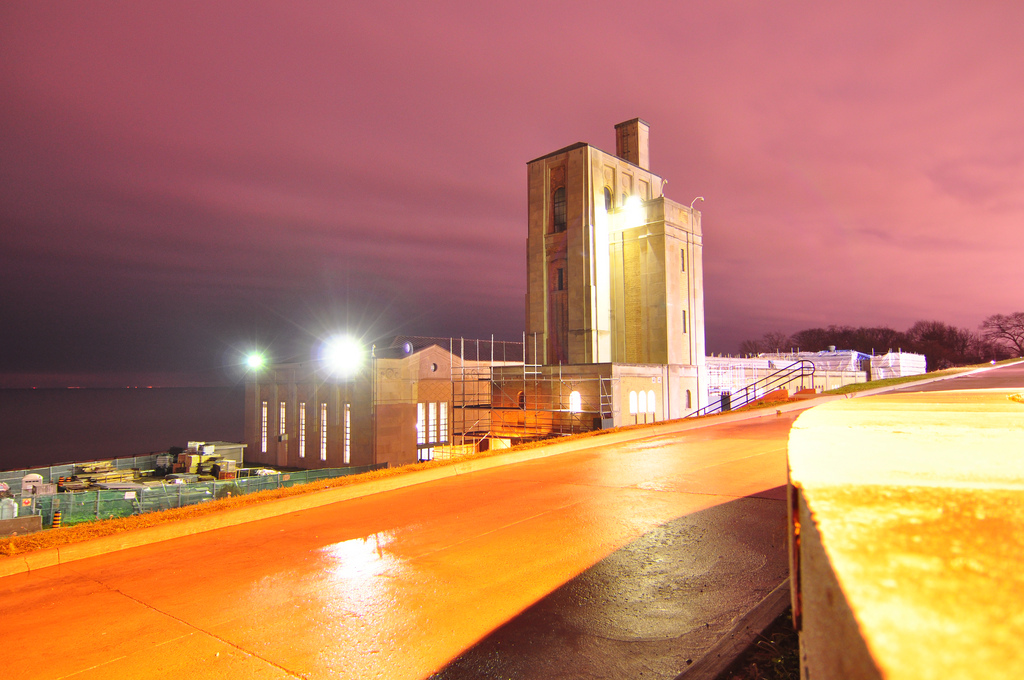
Players build infrastructure like this Toronto, Ontario water treatment plant. Image: Lucas Richarz. Some rights reserved.
By Steven Maier
Faculty at Indiana University are building a video game to teach people about water systems and infrastructure.
Players create a functioning residential water system by tackling increasingly difficult challenges and larger responsibilities. New industrial and agricultural areas pose new unique challenges. Players counteract pollution and distribute water efficiently by expanding and upgrading the system, adding new lines, water towers and treatment plants. distribute water efficiently by making changes and upgrades to their infrastructure.
Later they manage areas affected by drought or past mismanagement.
The goal is to teach kids and adults where their drinking water comes from, said Shahzeen Attari, assistant professor at Indiana University. It’s a system that many don’t seem to understand, according to a recent study that Attari co-authored. And that lack of understanding makes it difficult to build support for improving the country’s water infrastructure that has largely fallen into disrepair.
Mike Sellers, a professor in the Media School at Indiana University, is helping Attari design the game. Sellers has designed a game for the U.S. military that teaches soldiers how to interact with civilians in foreign countries. He also was the lead designer on the popular 2004 life simulation game, The Sims 2. The water project shares some of the elements of that game. Both afford players a high level of freedom and ask them to strive for the best outcome.
Indiana University will host the game online within two years to allow for easy access, Sellers said. The team hopes to convince schools to use it. It is designed to appeal to kids in middle school up to adults and should be appealing to anyone interested in games that involve building, creating and watching things develop. Designers plan to create a free version for school distribution and possibly a fleshed-out paid version.
Sellers and Attari have enlisted the help of university students and local game development firm Studio Cypher to help with production.
Though Americans don’t seem to know much about their water, Sellers has faith in their project.
“Using a game like this, can we improve that understanding,” he said. “We’re pretty confident that we can do that . . . but we haven’t done it yet.”
This is Attari’s first foray into video games, but she said it seems like “a natural progression” for her work. They could have just published diagrams of the water system, she said, but she feels there’s more potential in interactive learning. The game will teach the players better, but the more important thing is to change behavior, she said.
“Really, we don’t want people to be super accurate if it doesn’t matter,” she said.
The hope is that further understanding will lead to more efficient use of water, she said. Many people don’t appreciate the energy and resources necessary to produce clean water. Attari isn’t sure the game will change that.
But she’s hopeful. The team will measure the game’s teaching effectiveness and ability to bring about behavioral change by inserting survey questions into the gameplay.
The design is well under way, with a “strong beta” expected within a year, Sellers said. Polishing for a final product ready to distribute to schools should be completed one year after.
The game is a good idea, said Janice Beecher, director of the Institute of Public Utilities at Michigan State University. It could shed light on infrastructure that’s largely out of sight.
“One of the issues we can have is that [water] infrastructure can often be invisible, Beecher said. “It’s underground, and so it’s invisible to consumers.”
The game gives players a chance to visualize that system, she said.
If it succeeds, the team will try to apply it to other systems.
“I’m just trying to figure out if there’s a way to get people to understand one system and take it from there,” Attari said.
The hope is that players will improve their systems thinking, Attari said.
Systems thinking is a problem-solving ability that allows a person to see how things in the system relate to one another–to see the part in light of the whole, she said. Good systems thinking can help a person understand the consequences of their actions and aid better decision making. Players’ management of the water system will act as a hands-on systems thinking exercise.
Attari’s hope is that familiarity with one system–water infrastructure–can help players recognize and learn about other systems, like those that produce gas and electricity.
The technology and resources exist to make necessary upgrades to our water infrastructure, Attari said. What is needed to move those efforts forward are public support and political will, both of which could be bolstered by a better-informed public.
Sellers believes that globalization and rising interconnectivity will soon render good systems thinking a necessary skill for contributing to society.
“If (people are) more informed about what the water system is and how it works, they’ll be better informed citizens overall,” Sellers said. “It’s just vitally important for us to see the world and understand its systems.”